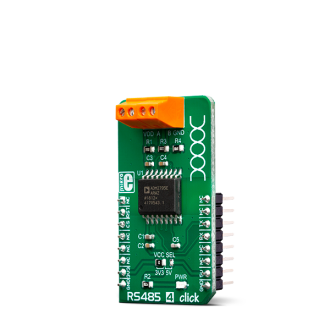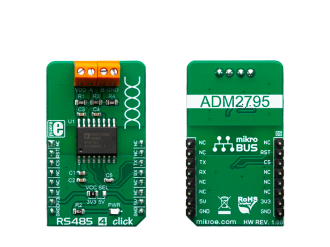
We strongly encourage users to use Package manager for sharing their code on Libstock website, because it boosts your efficiency and leaves the end user with no room for error. [more info]

Rating:
Author: MIKROE
Last Updated: 2019-03-15
Package Version: 1.0.0.0
mikroSDK Library: 1.0.0.0
Category: RS485
Downloaded: 4823 times
Not followed.
License: MIT license
RS485 4 Click offers an UART to RS485 signal conversion, featuring the ADM2795E specialized IC with the complete galvanic isolation.
Do you want to subscribe in order to receive notifications regarding "RS485 4 click" changes.
Do you want to unsubscribe in order to stop receiving notifications regarding "RS485 4 click" changes.
Do you want to report abuse regarding "RS485 4 click".


Library Description
Initializes and defines UART bus driver, and defines driver's functions for comunication (reading and writing) between RS485 4 clicks.
Key functions:
uint8_t rs4854_byteReady() - Check for new byte receiveduint8_t rs4854_readByte() - Read Single Bytevoid rs4854_writeByte(uint8_t input) - Write Single ByteExamples description
The application is composed of the three sections :
void applicationTask()
{
char tmp;
uint8_t rdyFlag;
// RECEIVER - UART polling
rdyFlag = rs4854_byteReady();
if (1 == rdyFlag)
{
tmp = rs4854_readByte();
mikrobus_logWrite( &tmp, _LOG_BYTE );
}
// TRANSMITER - TX each 2 sec
/* for (tmp = 0; tmp < 9; tmp++)
{
rs4854_writeByte( MESSAGE_DATA[tmp] );
mikrobus_logWrite( "MESSAGE SENT", _LOG_LINE );
}
Delay_ms(2000);*/
}
Other mikroE Libraries used in the example:
UARTConversionsAdditional notes and informations
Depending on the development board you are using, you may need USB UART click, USB UART 2 click or RS232 click to connect to your PC, for development systems with no UART to USB interface available on the board. The terminal available in all MikroElektronika compilers, or any other terminal application of your choice, can be used to read the message.